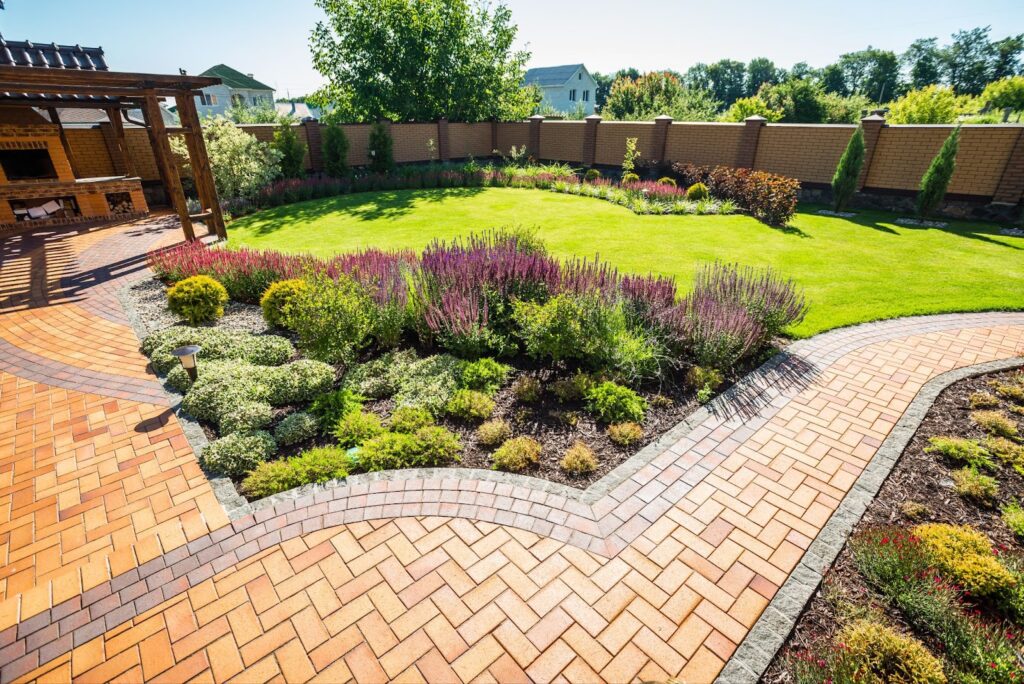
Erosion, or soil displacement by wind, water, and other forces, is a severe problem in landscape construction that can diminish a yard’s visual appeal and cause long-term property damage. That is especially true for those on sloping land, near waterways, or in areas prone to heavy rainfall. Besides forming unsightly muddy puddles, it can also cause problems that call for expensive repairs and maintenance, including:
- Soil Loss
- Uneven Terrain
- Structural Destabilization and Damage
- Drainage Issues
- Flooding
Beyond the direct impact on homes, erosion can degrade the environment. Runoff water from displaced soil may contain pollutants, pesticides, and sediments. If the runoff infiltrates surrounding water bodies, the area’s water quality and aquatic ecosystems can be severely compromised.
Without a doubt, erosion can turn your dream oasis into a nightmare. Fortunately, there are numerous erosion control strategies you can implement.
Install Retaining Walls
Building and strategically placing retaining walls is one of the most practical and common methods of preventing soil displacement, especially in sloped backyards. These robust barriers keep soil from sliding downhill or washing away when heavy rain falls.
Aside from their practical benefits, retaining walls can give your landscape a neat and structured look. They come in various styles and materials, including concrete, stone, brick, and wood, so you can select an option that best complements your outdoor area’s overall design. When incorporated with plants, they also make for attractive tiers in your yard, giving you more usable space on your sloped terrain.
Plan Your Drainage System
Ensuring smooth water is another crucial aspect of your landscape’s design. Proper drainage prevents water buildup, which could otherwise weaken and destabilize retaining walls, ultimately reducing the risk of soil displacement.
Consider installing a French drain system made of perforated pipes in a trench to redirect water from vulnerable areas in backyards and gardens efficiently. You can also use dry creek beds and swales, which are shallow, sloped, rock-filled trenches, to reroute water while maintaining the area’s natural look.
Building a rain garden is another option if you prefer an eco-friendly solution. It’s a shallow cavity containing native and water-tolerant plant species to capture and let rainwater naturally seep back into the ground.
Build a Silt Fence
Silt fencing is a critical erosion control strategy for landscape construction work in properties connecting to bodies of water. Geotextile fabric makes up temporary barriers around the building site to collect sediments and prevent them from contaminating waterways.
This measure is most useful during construction since the soil is most vulnerable to erosion during this phase. The contractors you’ll work with will remove the silt fence once the project is complete. Afterward, you can implement other erosion control methods to maintain soil protection.
Incorporate Terraces
Terracing can be a game-changer if your outdoor area is on a slope. It involves cutting into the hill and forming leveled, step-like sections. Each terrace holds the soil in place like a mini retaining wall and slows down water runoff, decreasing the risk of soil displacement.
This method also gives you more planting space in an otherwise challenging area, allowing you to maximize your backyard’s potential. The terraces can be designed using natural stone, wood, or other materials, depending on your preferred aesthetic.
Use Ground Cover and Vegetation
Incorporating plants, grasses, and perennials is a natural and visually pleasing way to manage erosion. Native vegetation, especially those with fibrous root systems that reach deep into the earth, can help hold the soil in place and lessen runoff.
Ground cover plants, in particular, are recommended since they spread quickly across the surface, providing excellent coverage for large areas and serving as an extra layer of defense from strong winds and water. You can also incorporate hardy, easy-to-maintain plants like creeping thyme, sedum, and vinca minor for slight slopes and flat areas.
Planting shrubs and trees is also an excellent way to ensure long-term erosion control, especially for extensive areas. The deep-penetrating roots stabilize soil, while their natural canopies can diminish the impact of rainfall on the ground and minimize the likeliness of soil getting washed away.
Plan Your Landscape’s Design With Expert Guidance
Proper erosion control helps your outdoor area retain its structural integrity and visual appeal. It keeps plants, flowers, and trees healthy, makes outdoor time more enjoyable, and generates long-term savings. Moreover, ensuring your landscape’s defense against erosion can boost your house’s market value and attract potential buyers if you’re considering selling your property.
Some erosion control measures may require an initial investment, but the significant benefits pay off in the long run. Contact trusted local landscaping professionals for more information or guidance in planning your outdoor space’s design.




More Stories
Monos: Revolutionizing Travel with Style and Functionality
How to Spot an HVAC Problem Before You Need an Expensive Repairman
Christmas baubles wholesale – the most beautiful decoration